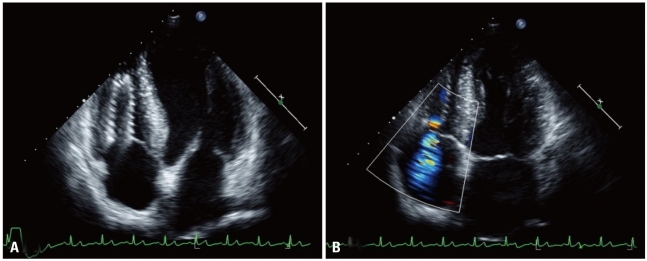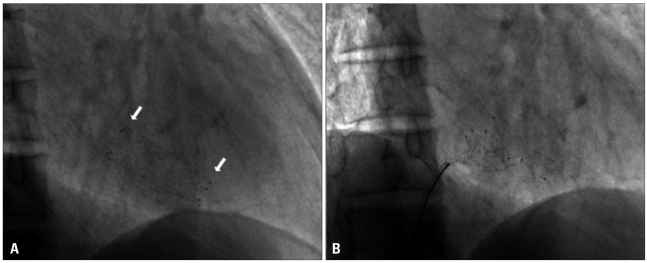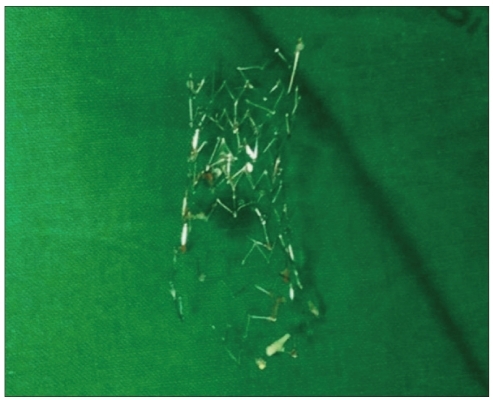J Cardiovasc Ultrasound.
2011 Dec;19(4):203-206. 10.4250/jcu.2011.19.4.203.
Surgical Removal of Endovascular Stent after Migration to the Right Ventricle Following Right Subclavian Vein Deployment for Treatment of Central Venous Stenosis
- Affiliations
-
- 1Department of Internal Medicine, Busan Veterans Hospital, Busan, Korea. tosca6212@naver.com
- 2Department of Thoracovascular Surgery, Kosin University Gospel Hospital, Busan, Korea.
- KMID: 1980384
- DOI: http://doi.org/10.4250/jcu.2011.19.4.203
Abstract
- Central venous stenosis or occlusion occurs in 11-50% of hemodialysis patients with prior subclavian vein cannulation and ipsilateral fistula or shunt. Most patients are asymptomatic but some require treatment to reduce the risk of thrombosis and improve inadequate hemodialysis pressure. In these cases, endovascular intervention, including ballooning and stenting, is a feasible strategy for selected patents. We report an unusual case of a 40-year-old man on hemodialysis that underwent endovascular stenting to treat right subclavian vein stenosis and experienced stent migration to the right ventricle, requiring surgical removal.
Keyword
MeSH Terms
Figure
Reference
-
1. Schillinger F, Schillinger D, Montagnac R, Milcent T. Post catheterisation vein stenosis in haemodialysis: comparative angiographic study of 50 subclavian and 50 internal jugular accesses. Nephrol Dial Transplant. 1991; 6:722–724. PMID: 1754109.2. Cimochowski GE, Worley E, Rutherford WE, Sartain J, Blondin J, Harter H. Superiority of the internal jugular over the subclavian access for temporary dialysis. Nephron. 1990; 54:154–161. PMID: 2314526.3. Schwab SJ, Quarles LD, Middleton JP, Cohan RH, Saeed M, Dennis VW. Hemodialysis-associated subclavian vein stenosis. Kidney Int. 1988; 33:1156–1159. PMID: 2969991.4. Surratt RS, Picus D, Hicks ME, Darcy MD, Kleinhoffer M, Jendrisak M. The importance of preoperative evaluation of the subclavian vein in dialysis access planning. AJR Am J Roentgenol. 1991; 156:623–625. PMID: 1781814.5. National Kidney Foundation. NKF-DOQI clinical practice guidelines for hemodialysis adequacy. Am J Kidney Dis. 1997; 30:S15–S66.6. Kovalik EC, Newman GE, Suhocki P, Knelson M, Schwab SJ. Correction of central venous stenoses: use of angioplasty and vascular Wallstents. Kidney Int. 1994; 45:1177–1181. PMID: 8007589.7. Gray RJ, Dolmatch BL, Horton KM, Romolo JL, Zarate AR. Migration of Palmaz stents following deployment for venous stenoses related to hemodialysis access. J Vasc Interv Radiol. 1994; 5:117–120. PMID: 8136587.8. Antonucci F, Salomonowitz E, Stuckmann G, Stiefel M, Largiadèr J, Zollikofer CL. Placement of venous stents: clinical experience with a self-expanding prosthesis. Radiology. 1992; 183:493–497. PMID: 1561356.9. Verstandig AG, Bloom AI, Sasson T, Haviv YS, Rubinger D. Shortening and migration of Wallstents after stenting of central venous stenoses in hemodialysis patients. Cardiovasc Intervent Radiol. 2003; 26:58–64. PMID: 12522643.10. Bartorelli AL, Fabbiocchi F, Montorsi P, Loaldi A, Tamborini G, Sganzerla P. Successful transcatheter management of Palmaz Stent embolization after superior vena cava stenting. Cathet Cardiovasc Diagn. 1995; 34:162–166. PMID: 7788697.11. Poludasu SS, Vladutiu P, Lazar J. Migration of an endovascular stent from superior vena cava to the right ventricular outflow tract in a patient with superior vena cava syndrome. Angiology. 2008; 59:114–116. PMID: 18319233.12. Srinathan S, McCafferty I, Wilson I. Radiological management of superior vena caval stent migration and infection. Cardiovasc Intervent Radiol. 2005; 28:127–130. PMID: 15602644.13. Dubois P, Mandieau A, Dolatabadi D, Chaumont P, Gurnet P, Thiriaux J, Delcour C, Creplet J. [Right ventricular migration of a stent after endovascular treatment of a superior vena cava syndrome]. Arch Mal Coeur Vaiss. 2001; 94:1180–1183. PMID: 11794986.14. Smayra T, Otal P, Chabbert V, Chemla P, Romero M, Joffre F, Rousseau H. Long-term results of endovascular stent placement in the superior caval venous system. Cardiovasc Intervent Radiol. 2001; 24:388–394. PMID: 11907745.15. El Feghaly M, Soula P, Rousseau H, Chaiban F, Otal P, Joffre F, Cerene A. Endovascular retrieval of two migrated venous stents by means of balloon catheters. J Vasc Surg. 1998; 28:541–546. PMID: 9737466.16. Taylor JD, Lehmann ED, Belli AM, Nicholson AA, Kessel D, Robertson IR, Pollock JG, Morgan RA. Strategies for the management of SVC stent migration into the right atrium. Cardiovasc Intervent Radiol. 2007; 30:1003–1009. PMID: 17605069.17. Gabelmann A, Kramer S, Gorich J. Percutaneous retrieval of lost or misplaced intravascular objects. AJR Am J Roentgenol. 2001; 176:1509–1513. PMID: 11373221.18. Prahlow JA, O'Bryant TJ, Barnard JJ. Cardiac perforation due to Wallstent embolization: a fatal complication of the transjugular intrahepatic portosystemic shunt procedure. Radiology. 1997; 205:170–172. PMID: 9314980.19. Slonim SM, Dake MD, Razavi MK, Kee ST, Samuels SL, Rhee JS, Semba CP. Management of misplaced or migrated endovascular stents. J Vasc Interv Radiol. 1999; 10:851–859. PMID: 10435701.20. Kadir S, Athanousilis CA. Athanasoulis CA, Green RE, Pfister RC, Roberson GH, editors. Percutaneous retrieval of intravascular foreign bodies. Interventional radiology. 1982. Philadelphia: WB Saunders;p. 379–390.
- Full Text Links
- Actions
-
Cited
- CITED
-
- Close
- Share
- Similar articles
-
- Tricuspid Valve Insufficiency due to Intracardiac Migration of a Stent Inserted into Rt. Subclavian Vein to the Right Ventricle after the Treatment of Central Venous Stenosis
- Urgent Endovascular Stent Graft Placement for Iatrogenic Subclavian Artery Rupture
- Percutaneous Recanalization for Refractory Dialysis-related Subclavian Vein Obstruction: A Case with Needle Puncture
- Endovascular interventions for central vein stenosis
- Incidental ipsilateral subclavian vein catheterization via right internal jugular venous route: A case report




